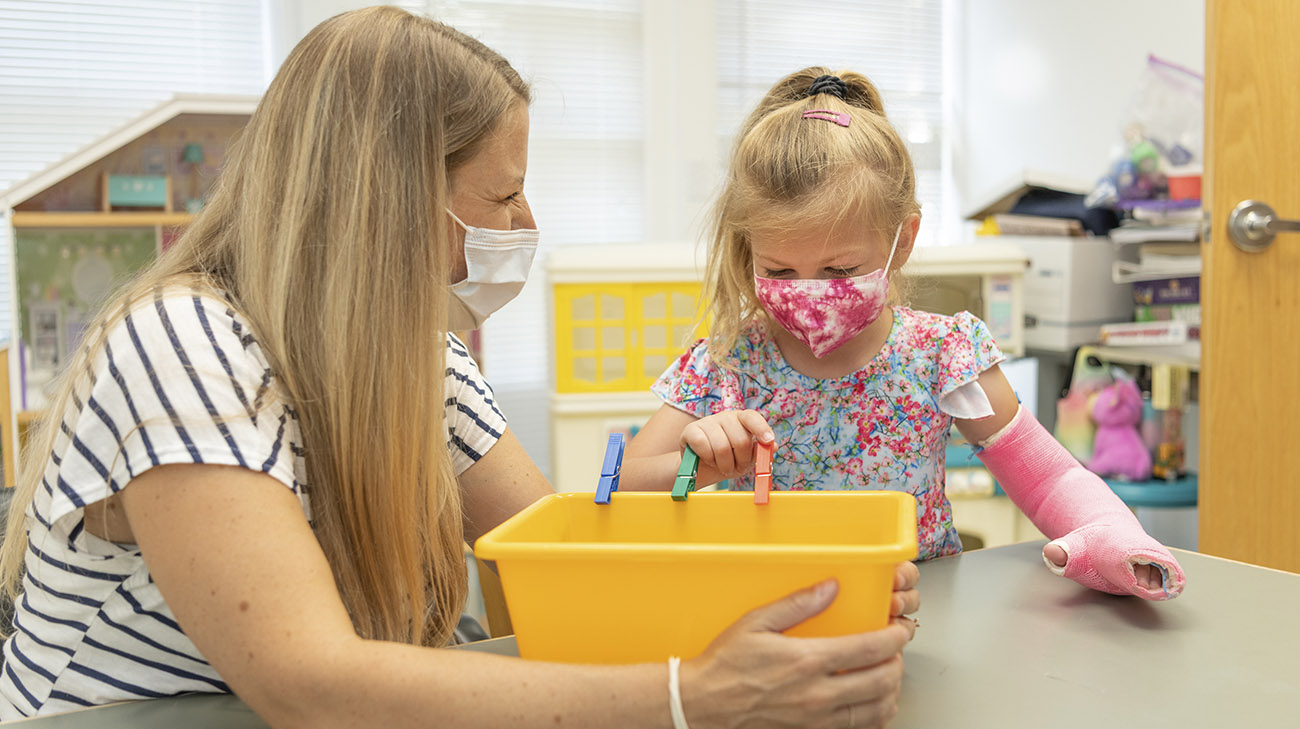
In 2015, when Denise Bell was 44 years old and in her third trimester of pregnancy, her doctors were concerned about a fetal brain scan. It showed decreased gray matter on the left side, indicating the fetus had a stroke. It also revealed a separate, rare condition, the lack of a septum pellucidum, a thin membrane between the hemispheres of the brain. Denise was told that this could cause her baby to be blind and have hormonal problems that might impede growth.
“I spent my last trimester in tears,” she says.
When her daughter, Madison, was born at a special delivery unit at Cleveland Clinic, “she was fine,” Denise says. “To date, her hormone levels are within the normal range, there are no issues with her growth, and though her optic nerves are extremely thin on the right side, she has perfect vision. She is a miracle child.”
However, at about 6 months old, Madison first exhibited a symptom typically seen in stroke patients. “Her thumb was tucked into her fist, super-tight, on her right side,” Denise says. “She never crawled because she could not hold herself up. She also was a late walker – close to age 2 – and a late talker, because the gross motor and language skills arise from the same area of the brain. She has been in occupational and physical therapy at Cleveland Clinic since she was 6 months old.”
When she turned 3 years old, Madison began a special, intense program at Cleveland Clinic Children’s Hospital for Rehabilitation – constraint-induced movement therapy, or CIMT. The program was among the first in Ohio when it was introduced in 2009 by occupational therapist Jessie Stricker, who trained with CIMT developers at the University of Alabama.
“It takes 110% commitment, and it’s 110% worth it.”
In this program for children experiencing difficulty using one arm, the unaffected upper extremity is placed in a cast for three weeks. During that time, the child must perform all self-care and fine-motor tasks using the affected arm. A family member or caregiver attends the program with the child to learn how to assist their child outside of therapy.
“Our program serves anyone with neurological impairment of one arm,” Jessie says. Like Madison, most of the children had a stroke in utero, she says, but in many cases, it was undetected. Usually, no cause is determined. Most of the children in the program were born full-term and healthy to healthy parents, she says. They usually are not diagnosed before the ages of 3 to 5 months, when infants typically begin reaching and grasping for objects.
CIMT retrains the child’s brain, Jessie says. “Most of our patients are close to 3 years old when they start and can’t use one hand at all or use it really poorly. When we take away the use of the other hand, they don’t know how to use their weaker one. We do a lot of education at the beginning, and the kids can become so fatigued because their brains are working hard.”
The program requires the child and caregiver to participate in therapy three hours a day, five days a week, for three weeks. “We need to sustain their attention,” Jessie says. “That’s why children are not admitted much before the age of 3.” The program can be repeated annually, for two weeks at a time. School-aged children often are eligible to move on to a special summer camp that includes a combination of traditional CIMT and training of both arms to work together through activities such as swimming, yoga and group exercise.
“We want their arms to be as strong as possible so that they can carry a lunch tray, tie their shoes or put their hair in a ponytail when they attend school,” Jessie says. “The parents also give us specific goals for their children.”

During the CIMT program for children experiencing difficulty using one arm, the unaffected upper extremity is placed in a cast for three weeks. Madison and friend, Tyler Bruns, show off their casts during a break from activities.
For Denise and Madison, the program was challenging at the start.
“So many times, I wanted to say ‘I can’t do this,’” Denise says. “At that point, Madison didn’t have any function at all with her right hand. It was hard to see her already affected arm not working, and now, she had to use it. She couldn’t even hold a French fry! There were so many tears and so much frustration. It was like starting from scratch. I’m not sure who shed more tears, her or me.”
Today, Madison, at 6 years old, is able to use her right hand in all aspects of her life. Denise and her husband, Erhardt, who also have 5-year-old twin boys, are impressed by her progress.
“Before, she did everything with her left hand, and her right hand was just a helper,” Denise says. “She wasn’t even really aware she had it. Now, she says, ‘Righty, wake up! Let’s do it!’ She has about 75 percent use in her right hand, and in the last year or so has been able to use a pencil with a pincer grasp.”
When they started CIMT, Denise says, “I was skeptical because watching her struggle was so hard. In hindsight, it was so worth it. We hung in there, and after all these years, I believe that Madison would not have as much function without it as she has now. It takes 110% commitment, and it’s 110% worth it.”
For more information on CIMT, visit: https://my.clevelandclinic.org/pediatrics/departments/constraint-induced-movement-therapy
Related Institutes: Cleveland Clinic Children's , Neurological Institute

